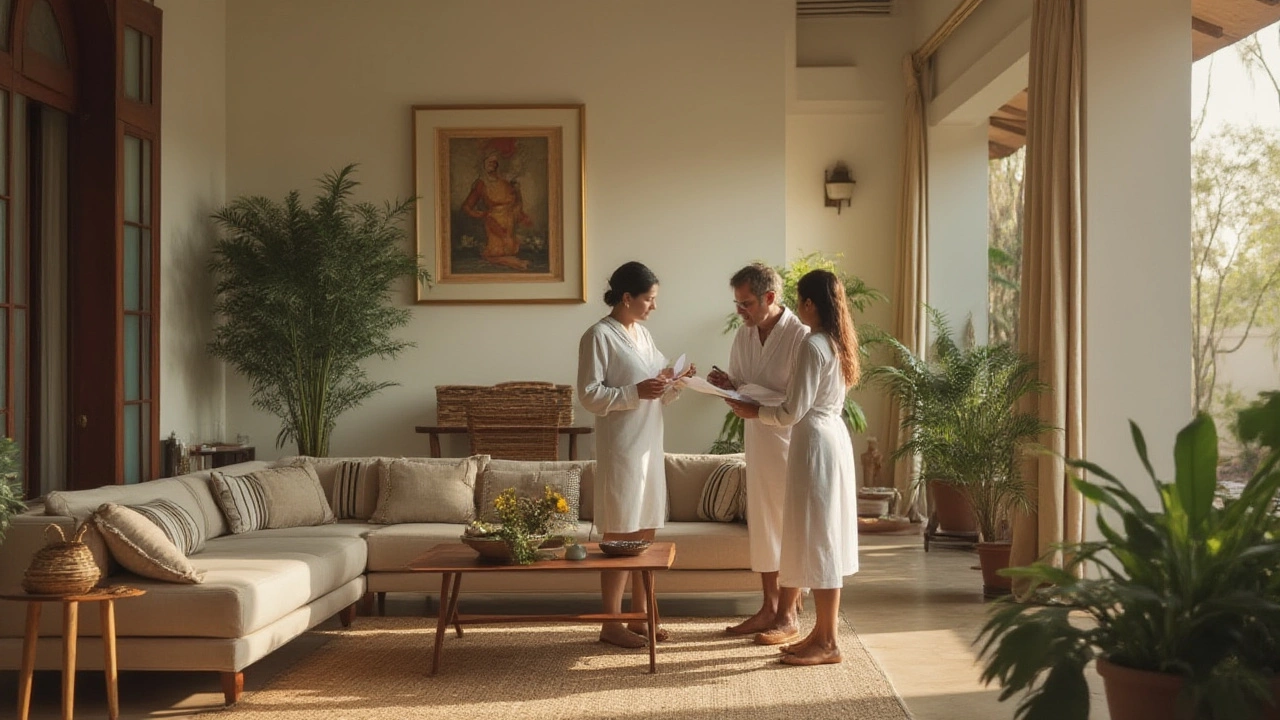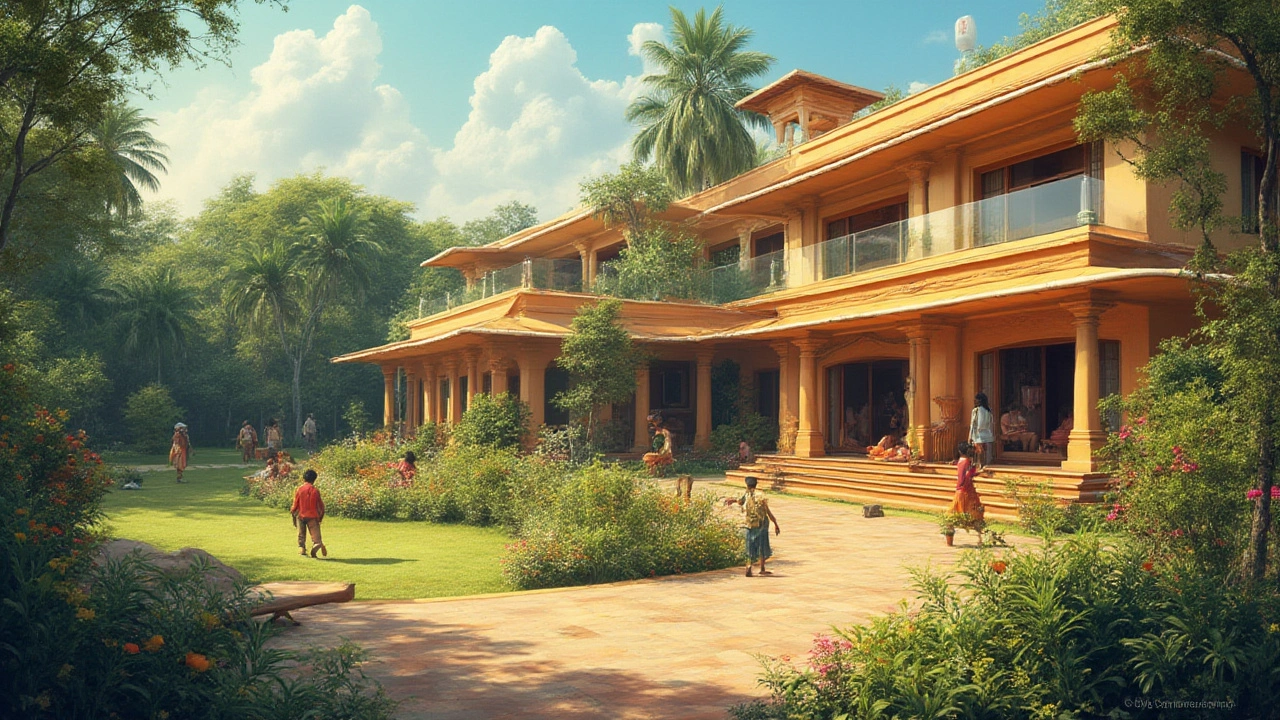Picture this: you wake up, sunlight spilling into a high-ceilinged bedroom, step out onto a balcony with a postcard view, and in the distance, hear the soft hum of a pool filter. No noisy neighbors above or under you. The privacy is unreal. But have you ever wondered what makes a villa tick—what actually goes on behind those ornate gates? Villas aren’t just about big rooms and pretty gardens. It’s a whole different lifestyle, powered by specific ownership models, teams of people, complex systems, and some surprising economics. Let’s tear back the curtains and see exactly how a villa really works.
Anatomy of a Villa: What Sets It Apart
First things first: a villa isn’t just a fancy name for a big house. There are real differences, and not just in curb appeal. Most villas are detached, often single or double-story buildings with large private grounds—think manicured lawns, a pool, and maybe a tennis court or even a guesthouse out back. Unlike standard houses or townhomes, the villa’s layout is all about flow and luxury. High ceilings, big windows, sprawling verandas, and light-filled living areas are common themes, built to maximize airflow and offer that all-important privacy.
Back in ancient Rome, “villa” basically meant a country house for aristocrats. These days, it’s become shorthand for upscale living, especially in hotspots like the French Riviera, Bali, or Miami. A villa’s architecture often teases in local styles: red-tiled roofs around the Med, open-sided pavilions in Southeast Asia, or even minimalist modern lines for that Malibu look. Some wow you with centuries-old stone walls, others with infinity pools and digital smart home tech.
It's not just about show. The anatomy of a villa involves layers of working systems—plumbing, electrical, climate control, security, landscape irrigation, and sometimes even solar power or backup generators. Behind every luxury soak in your freestanding tub or backyard swim, there’s engineering humming away. For those eco-minded, new villas often use rainwater catchment for gardens, low-voltage LED lighting, and clever waste management. The best part? You rarely see any of it, because villas are designed for everything to work quietly in the background.
And these places are huge compared to average homes: a global 2024 survey showed the average villa built in Europe in the last five years sits at around 3,500 square feet (325 sqm) of indoor space, plus twice that again outdoors. If you’re comparing, the average new apartment in Paris hovers at just 650 square feet (60 sqm). Clearly, villas are in a league of their own.
Ownership Models: Owning, Renting, or Sharing
How you enjoy a villa depends on your name on the deed, your lease, or your club card. Let’s break down the three most common ways villas are made available: owning outright, renting short-term or long-term, or buying into fractional/shared villas.
Owning outright seems straightforward, but there’s a twist. Many luxury villa developments nowadays are run as gated communities or estates, managed by a homeowner’s association (HOA). Each owner gets a title deed but pays ongoing HOA fees for security gates, private roads, shared gyms, pools, or golf courses. In Spain’s Costa del Sol or Dubai’s Emirates Hills, these fees aren’t pocket change—anywhere from $2,500 to over $15,000 per year, depending on the amenities.
Take a look across the world, and you’ll see different rules. In Thailand, for example, foreigners can’t own land outright, but they can lease a villa long-term (usually 30 years, renewable). In Bali, you get a similar deal—"right to use" agreements, not freehold. In the UK or Australia, freehold is king, and you own inside and out. Always check the legal nitty-gritty if you’re shopping abroad; rules and taxes can sting.
Don’t have $2 million free? Renting a villa has become ridiculously popular for holidays or remote work escapes. Short-term vacation rentals run the show in regions like the Caribbean and the Greek Islands, where you might book a week or a whole season. Rental platforms have grown up fast: in 2023, 21% of luxury villa bookings were by families planning reunions—up from 13% in 2019. The trick here is, when you rent, you get all the trimmings but none of the paperwork or maintenance stress. But, high demand means you’ll want to book far in advance—especially peak season.
If the flexibility of rental and the pride of ownership had a baby, you’d get fractional ownership or timeshare. Several people split the cost, rotating use by week or season. Buyers get a legal share (and responsibilities), the property is managed professionally, and your upfront spend drops sharply—sometimes by 70-80% compared to buying solo. This model is super popular in ski hotspots like Aspen or coastlines like Costa Rica. If you don’t mind sharing, it’s a clever hack into villa living.
Here’s a quick breakdown:
| Model | Main Costs | What You Get | Commitment |
|---|---|---|---|
| Outright Ownership | Purchase, stamp duty, annual taxes, HOA | Full access & control | High (multi-year) |
| Rental | Nightly/weekly fee, deposit | Temporary stay | Low (days to months) |
| Fractional | Buy-in share, fees | Guaranteed stay periods | Medium (yearly) |

How Does a Villa Actually Run? The People and Systems
What makes a villa tick day-to-day isn’t magic—it’s people, processes, and technology. Think of it like a boutique hotel mixed with a private home, with layers of service and management humming in the background to keep everything perfect.
Staffing is a biggie. In many regions, especially in Bali, Mykonos, or the Caribbean, every villa runs with a small crew: a housekeeper or two, a gardener, maybe a pool tech or a security guard. High-end properties often employ a live-in property manager or butler. In places like Phuket or Saint-Barth, you can find teams who learned the job at five-star resorts and now manage luxury villas like pros. Some owners outsource to a property management company—they handle bookings, maintenance, and even guest check-in while you kick back.
It’s not just about warm towels and spotless floors. Villas need regular TLC: roofs checked, pools cleaned, pests managed, gardens trimmed, and tech maintained. A single clogged gutter or broken pump isn’t just annoying—it can damage property worth millions. Many owners now use smart home systems for automated pool pH tests, humidity sensors, and remote security. In 2023, 42% of Spanish luxury villa owners paid for remote camera systems and smart irrigation to minimize emergencies while traveling. Some even subscribe to maintenance plans, kind of like car service packages, for peace of mind.
Let’s talk supplies. Villas often have bulk-buy deals with local suppliers for water delivery, garden soil, cleaning products, or groceries. In touristy centers, you can even arrange chef-prepared meals or stock the fridge before arrival. The pandemic gave rise to “contactless villa stays” where guests get a sanitized home with digital lock access, automatic check-in, and zero staff overlap.
Here’s a fun fact: a 12-month study in Marbella found that well-managed villas cost about 35% less in unplanned repairs than DIY homes, mostly because professional teams keep risks low. The up-front cost, then, often saves far more in the long run.
How about when you’re away? Savvy owners turn their villa into income engines, renting out during unused periods. Platforms like Airbnb Luxe or Onefinestay report that some premium listings pull in over $20,000 a month in peak season—enough to cover mortgage, taxes, and annual fees (or a new convertible). The catch? You have to keep standards sky-high and be ready for wear and tear. If you’re considering it, make sure you know the legal landscape: short-term lets are strictly regulated in cities like Barcelona and banned in some parts of Australia.
Everyday Life Inside a Villa: Experience and Hidden Costs
So, what is life actually like inside a villa? Day to day, it’s a different world from apartments or suburban homes. Privacy, space, custom details, and resort-level extras make it special—but there are trade-offs too.
The perks are obvious: host big family brunches by the pool, do yoga alone at sunrise, or just binge Netflix without any neighbors stomping overhead. Villas are made for entertaining: many are laid out with giant kitchens, inside and outside dining, al fresco bars, or fire pits. Whether you love to cook yourself or hire a private chef for a birthday dinner, the sky’s the limit. That’s why birthday groups, work retreats, and digital nomads flock to villas—they’re the ultimate ‘one stop’ escape.
But staying in or owning a villa means you handle—or pay for—every last detail: pool chemicals, garden fertilizer, seasonal AC servicing, that fence that needs repainting every four years. Some older villas drink up maintenance cash like a thirsty camel, especially if they’re built in a damp or very sunny climate. Expect energy bills to sometimes double what you’d pay in a city flat, thanks to big open rooms and garden irrigation. Solar panels can help, but they’re an up-front investment.
Security is another daily concern. In most countries, villa owners do more than basic locks—think camera networks, automatic gates, alarm sensors, and sometimes even private patrols in luxury estates. It’s not about paranoia, just peace of mind when you’re off work or overseas. Many HOA communities bundle this into your monthly fees, leaving you to enjoy the quiet without the worry.
Then, there’s the location. Villas tend to sit outside city clutter, with room to breathe—so having a car is almost a must. Yes, some French and Italian coastlines let you walk straight to the village bakery, but most villa life means driving. Add in deliveries (groceries, wine, flowers), school runs, and maintenance crews, and a parking area quickly fills up. That’s part of the trade-off for views, nature, or beach access at your doorstep.
And if you embrace the rental side, expect a rhythm to your calendar: open for friends and family in spring, booked for strangers in the busy summer, quiet repairs in the autumn. Many owners build in downtime so they can personally relax and recharge without the pressure of rental reviews or tight guest changeovers.
Here’s a quick cost comparison to put it in perspective:
| Expense Type | Villa (yearly avg) | Apartment (yearly avg) |
|---|---|---|
| Basic utilities & maintenance | $6,000 | $1,800 |
| HOA/Community fees | $3,500 | $850 |
| Insurance | $1,600 | $900 |
| Repairs/Upgrades | $4,000 | $1,200 |
The best tip? If you’re thinking villa life suits you, try renting first—in a spot and style you love. Spend at least a month, if you can, handling routines, paying attention to what staff really do, seeing what quirks annoy you, and talking to neighbors. If you’re serious about buying, always check with a local lawyer or notary before signing any deal, especially abroad.
Villas are more than trophy homes. They’re complex machines, driven by systems, people, and routines the average apartment dweller never thinks about. But if the idea of your own piece of paradise—where every detail runs just how you like—fires you up, a villa might be exactly your speed.

